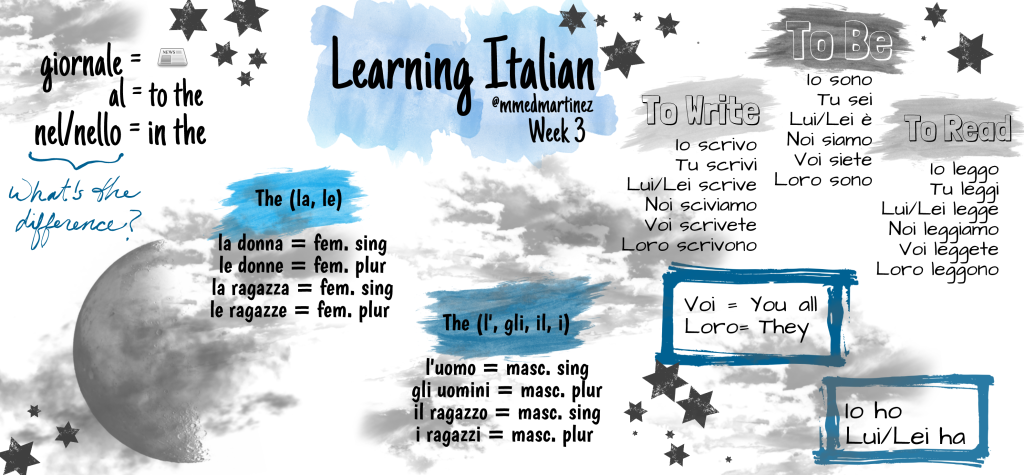Grammatical realizations
My classmate Riley has also taken on the challenge of learning a new language, and just like him, this week my addiction to Duolingo became evident. So far, I’ve only explored using the Duolingo App.
Although I had planned to use other methods for learning the language, I have found the app is the best way to keep on track with my goals. Every day, I receive notifications saying that it’s time to keep practicing in order to reach my daily goal. I find this extremely motivating as small, short-term goals are always easier to reach than overwhelming yourself to learn a list of new vocabulary each day.
I have found myself very committed to doing my daily Duolingo work regardless of other commitments going on in my life. Riley does a great job of explaining how the app embodies principals of gamification. It has definitely turned something that is not always interesting, into a game.
In my other class (EC&I 858: Theories and Research in Second Language Acquisition, Bilingualism & Multilingualism – highly recommended!), we’ve discussed how people will often apply grammatical rules of their first language to the new language they are learning. Cook and Singleton (2014) differentiates between ‘pro-drop‘ and ‘non-pro-drop’ languages. They explain that languages such as English and French are considered non-pro-drop languages because their grammatical structure always requires sentences to have a subject (I’m Canadian or It’s snowing). Other languages such as Spanish and Italian, the use of a subject in a sentence is optional (Is snowing or Is three o’clock). The following is Box 4.6 from Key Topics in Second Language Acquisition on page 61 and provides other examples of languages in either of these categories.
| Pro-drop Languages Allow subject-less sentences | Non-pro-drop Languages Do not allow subject-less sentences |
| Arabic Chinese Greek Hebrew Italian Japanese Portuguese Etc. | Dutch English French German |
After having learned this, I came to a huge realization that my parents (whom often say subject-less sentences) are really just applying Spanish grammatical rules to their second language. I have found myself doing the same when using Duolingo – I will often times automatically use a subjects in the sentences I write, although I know it is not required. This week, however, I tried omitting the subjects in the sentences I created, and to my surprise, the app still accepted them!
The following is a visual representation of my learning for the week. I used last week’s image as a template for this next one which saved me time. One of Sketchpad‘s many great features is that you can save your images onto your Google Drive account – so even though the program is a website, if I am logged into my Google account, the website will be able to bring up my previously saved pieces.

For this week’s video, I had screen recorded a few minutes every day of the week, but my first day of the week was the most exciting, so I only used Wednesday’s footage for this video. If you notice in the image above, ‘the’ can be said in six different ways, and this week I finally found something to help me figure out when to what (either la, le, l’, gli, il, and i).
What I learned:
- My English grammar will likely influence the way I speak Italian
- Italian verbs: to be, to read, to write
- If I pause while screen recording myself, this makes it much easier to edit
- How to use the correct version of ‘the’ in an Italian sentence
- My video editing skills on WeVideo are improving
Where I can improve:
- Using something other than just Duolingo to show my learning progress
- Potentially make my videos more exciting
- Show more of the mistakes I make – potentially showing a brand new lesson with content I haven’t seen or practiced
I’m curious to know if anyone else knew about those pro-drop and non-pro-drop languages. Have you ever heard people speak English and omit the subject in a sentence?
Citations
Cook, V. & Singleton, D. (2014). Chapter 4 of Key Topics in Second Language Acquisition. Bristol, UK: Multilingual Matters.

Hi Daisy, I enjoyed reading your blog post this week. I hadn’t heard of the pro-drop and non-pro-drop languages that you discuss. Since English and Italian fall in different categories with regard to this, are you finding it to be more or less difficult to learn Italian after being accustomed to the grammar rules of English?
I am glad you are getting more accustomed to WeVideo. I am feeling the same with iMovie in my project. I really enjoy watching your vlogs. Thanks for the update and good luck next week!
LikeLike
Thanks for the question, Brooke – I definitely find that I use subjects in the sentences that I write more often than not. I realize that this is considered less authentic or ‘native-like’ for Italian language users, but it is always something I catch myself doing. I guess it’s not necessarily wrong, it just gives off a more formal tone.
LikeLike
I like how thorough your posts are Daisy. I think there are interesting similarities and differences in our approaches and blogs, which I like considering. Your comment about pro-drop languages was very informative, because I’ve been noticing it seems like words are sometimes missing in Spanish sentences I’ve been working with, but it turns out that’s the reason. Duolingo doesn’t do a good job of explaining that unless you dig into the back end, which I doubt most people do.
I’ll be sure to keep comparing what we are each doing!
P.S. The Sketchpad looks great–very professional.
LikeLike
Thanks, Riley! I also enjoy reading your approach to the language. It’s definitely interested to compare perspectives! I’m glad I could help clarify some confusion. There are times in Duolingo that I am so confused.. it really does take effort to dig up the grammatical rules!
LikeLike